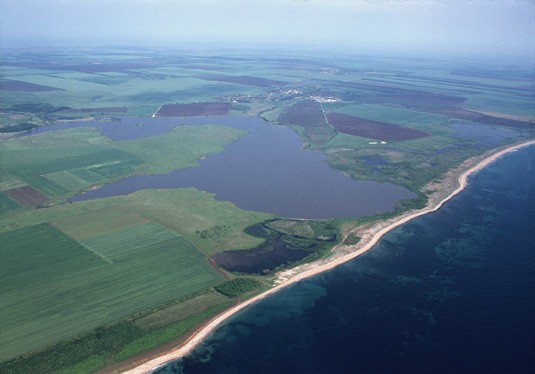m (New page: thumb|200px|right|An aerial photograph of the Durankulak Lake. This photo was made by Pavel Simeonov (www.branta-tours.com). Durankulak lake is a coastal lago...) |
(Deleted advertising content) |
||
| (14 intermediate revisions by 5 users not shown) | |||
| Line 1: | Line 1: | ||
| − | [[Image:Durankulak_Lake.jpg|thumb| | + | {{incompletelocation}} |
| − | + | [[Image:Durankulak_Lake.jpg|thumb|550px|right|Durankulak Lake from the air.<br />Photo by {{user|Pavel|Pavel Simeonov}}]] | |
| + | ==Overview== | ||
| + | Durankulak lake is a coastal lagoon, situated in North-east of Bulagria and separated from the Black Sea by sand dunes and a beach. It has an area of 446 ha. of which 250 ha. are open water and the rest is aquatic emergent vegetation. It is surrounded by grassland and arable agriculture. | ||
| − | '' | + | ==Birds== |
| − | + | ===Notable Species=== | |
| + | It is an important bird area and protected Ramsar site situated on the migratory flyway ''Via Pontica'' and is serving as major staging point for large gatherings of birds: [[Pygmy Cormorant]], [[Glossy Ibis]], [[Great White Pelican]] and [[Dalmatian Pelican]], [[Ruddy Shelduck]], [[Red-crested Pochard]], with many waders and small passerines in evidence. It represents the biggest wintering site for the [[Red-breasted Goose]] with over 40,000 individuals, 45% of the global population. It is also a winter home for over 30% of the western Palearctic population (11% of the global population) of [[Greater White-fronted Goose]] with over 235,000 individuals. | ||
| + | |||
| + | Over 80 species breed in this site including: [[Ferruginous Duck]] (Aythia nyroca), [[Collared Pratincole]] (Glareola pratincola), [[Stone Curlew]] (Burhinus oedicnemus), [[Red-footed Falcon]] (Falco vespertinus), [[Great Bittern]] (Botaurus stellaris), [[Little Bittern]] (Ixobrychus minutus), [[Eastern Olivaceous Warbler]] (Hippolais pallida) or [[Ortolan Bunting]] (Emberiza hortulana). | ||
| + | |||
| + | Durankulak Lake is also one of the few places in Europe where [[Paddyfield Warbler]] (Acrocephalus agricola), a typical Asian Species, can be seen. | ||
| + | ===Check-list=== | ||
| + | {{BirdsSee| | ||
| + | ''To do''}} | ||
| + | |||
| + | ==Other Wildlife== | ||
| + | ''To do'' | ||
| + | |||
| + | ==Site Information== | ||
| + | |||
| + | ===History and Use=== | ||
| + | ''To do'' | ||
| + | |||
| + | ===Areas of Interest=== | ||
| + | ''To do'' | ||
| + | |||
| + | ===Access and Facilities=== | ||
| + | The Branta Conservation and Visitor center is located close to the lake proper, not far from the international motorway, at 3 km from the Romanian border (www.birdinglodge.com). | ||
| + | |||
| + | ===Contact Details=== | ||
| + | ''To do'' | ||
| + | |||
| + | ==External Links== | ||
| + | *[http://www.beachbulgaria.com/shabla/pages/durankulak_lake_en.html Beach Bulgaria] | ||
| + | *[http://maps.google.co.uk/maps?f=q&source=s_q&hl=en&geocode=&q=Durankulak+lake&sll=43.699527,28.526773&sspn=0.026186,0.073214&g=Durankulak&ie=UTF8&ll=43.676439,28.527718&spn=0.052393,0.146427&t=h&z=13 Durankulak Lake on Google Maps] | ||
| + | |||
| + | ''Content and images originally posted by Pavel Simeonov (http://www.branta-tours.com)" | ||
| + | <!-- --> | ||
<gallery> | <gallery> | ||
Image:Lac_Durankulak2.JPG | Image:Lac_Durankulak2.JPG | ||
</gallery> | </gallery> | ||
[[Category:Bulgaria]] [[Category:Locations]] | [[Category:Bulgaria]] [[Category:Locations]] | ||
Latest revision as of 09:41, 8 November 2011
| This article is incomplete. This article is missing one or more sections. You can help the BirdForum Opus by expanding it. |
Overview
Durankulak lake is a coastal lagoon, situated in North-east of Bulagria and separated from the Black Sea by sand dunes and a beach. It has an area of 446 ha. of which 250 ha. are open water and the rest is aquatic emergent vegetation. It is surrounded by grassland and arable agriculture.
Birds
Notable Species
It is an important bird area and protected Ramsar site situated on the migratory flyway Via Pontica and is serving as major staging point for large gatherings of birds: Pygmy Cormorant, Glossy Ibis, Great White Pelican and Dalmatian Pelican, Ruddy Shelduck, Red-crested Pochard, with many waders and small passerines in evidence. It represents the biggest wintering site for the Red-breasted Goose with over 40,000 individuals, 45% of the global population. It is also a winter home for over 30% of the western Palearctic population (11% of the global population) of Greater White-fronted Goose with over 235,000 individuals.
Over 80 species breed in this site including: Ferruginous Duck (Aythia nyroca), Collared Pratincole (Glareola pratincola), Stone Curlew (Burhinus oedicnemus), Red-footed Falcon (Falco vespertinus), Great Bittern (Botaurus stellaris), Little Bittern (Ixobrychus minutus), Eastern Olivaceous Warbler (Hippolais pallida) or Ortolan Bunting (Emberiza hortulana).
Durankulak Lake is also one of the few places in Europe where Paddyfield Warbler (Acrocephalus agricola), a typical Asian Species, can be seen.
Check-list
Birds you can see here include:
To do
Other Wildlife
To do
Site Information
History and Use
To do
Areas of Interest
To do
Access and Facilities
The Branta Conservation and Visitor center is located close to the lake proper, not far from the international motorway, at 3 km from the Romanian border (www.birdinglodge.com).
Contact Details
To do
External Links
Content and images originally posted by Pavel Simeonov (http://www.branta-tours.com)"





